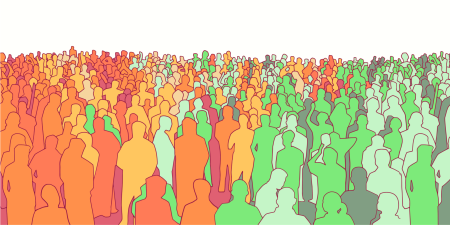The discovery that cases of paralytic polio in 1955 were caused by a single manufacturer of Salk vaccine, the linkage of toxic shock syndrome to tampons in 1979, the identification of the sentinel cases of AIDS on the East and West coasts in the early 1980s, the recognition of West Nile, SARS, and avian flu at the turn of the twenty-first century—were all the result of surveillance systems, through which alert and troubled physicians could communicate with public health officials, thus enabling emerging patterns to be identified. In each instance, such vigilance made it possible to initiate measures that could limit the human toll.
Surveillance serves as the eyes of public health. Name-based reporting of cases has provided the foundation for planning, intervention, and prevention and has been critical for epidemiological research into patterns of morbidity and mortality for a wide variety of diseases and conditions. Registries have been essential for tracking individuals and their conditions over time. Surveillance has also served to trigger the imposition of public health control measures, such as contact tracing, mandatory treatment, and quarantine. The threat of such intervention and long-term monitoring has provoked alarm and rendered surveillance suspect for those concerned about the unwarranted exercise of state authority in the name of public health. Thus the history of surveillance has been bounded by a promise and a specter.
Over the course of the 20th century, public health officials reiterated the importance of surveillance, arguing that without the name and location of diseased individuals they worked "in the darkness of ignorance" and might "as well hunt birds by shooting into every green bush" [1]. It was the prospect of what surveillance might offer that raised hopes—for the delivery of services, for lifesaving knowledge, and for protection of individuals and communities.
Hermann Biggs, a titanic figure in the history of public health, who was perhaps the most important late 19th- and early 20th-century architect and philosopher of U.S. public health surveillance, made it clear that names of the diseased were never collected "in order to keep clerks or adding machines busy" [2]. Toward the end of the 20th century, Surgeon General David Satcher would state the value of surveillance as plainly as had Biggs: "In public health, we can't do anything without surveillance.that's where public health begins" [3]. When surveillance opened the doors to vital services and knowledge, its subjects could well become among its most ardent advocates, thus underscoring a politics that goes beyond the politics of privacy.
In the late 19th and early 20th centuries, as public health was extending the ambit of surveillance, the medical community reacted with hostility, particularly when it came to tuberculosis surveillance and seemingly threatened to intrude on the sanctity of the clinical relationship, over which the physician was guardian. Medical Record editor George Shrady thus complained of TB surveillance,
The compulsory step taken is a mistaken, untimely, irrational, and unwise one.... The real obnoxiousness of this amendment to the sanitary code is its offensively dictatorial and defiantly compulsory character. It places the Board [of Health] in the rather equivocal position of dictating to the profession and of creating a suspicion of an extra bid for public applause [4].
"Already," he continued, "the profession as a whole has watched with jealous eye the encroachments of the Board upon many of the previously well-recognized privileges of the medical attendant" [4].
Over time, disease reporting was extended to chronic, noncontagious conditions such as cancer, birth defects, and occupational illnesses. Not only physicians but laboratories were often required to report cases to local health authorities. The surveillance of chronic diseases, of course, differs because these conditions do not represent a direct threat to the health of others. And, indeed, when state and local health departments first began tracking conditions like congenital malformations and cancers in the first half of the 20th century, these initiatives typically served epidemiological or research purposes only. These reporting efforts, critically, also became linked to the assessment and improvement of clinical care. Tumor registries, for example, emphasized patient care improvement since the 1950s and, currently, data from the National Cancer Institute's SEER program (Surveillance, Epidemiology, and End Results Program) are routinely used for quality improvement initiatives.
It was not until the AIDS epidemic that activists challenged the long-standing tradition of name-based reporting. Even so, as AIDS has become a more treatable disease, resistance to reporting has all but vanished. In the 1990s, the promulgation of national standards to safeguard the privacy of medical records, as dictated by HIPAA (the Health Insurance Portability and Accountability Act), provoked intense public debate. But there was virtually no opposition to carving out an exception in the guidelines for the reporting of diseases to public health agencies. While there was initial uncertainty among physicians and researchers about whether hospitals could continue to provide cancer data to state registries, the Department of Health and Human Services made clear that HIPAA did not serve as an obstacle to reporting.
In the early 20th century it was physicians who spearheaded opposition to surveillance; since the 1970s, patients have often been at the forefront of challenges to reporting diseases. Parents of children with disabilities, for example, successfully changed the terms of birth defects surveillance in Minnesota, requiring the state to allow unwilling parents to opt out of reporting. Patient advocates within the American Diabetes Association forced New York City health officials to place limits on an initiative to track cases of diabetes.
But just as often, patients with serious illnesses have pushed for better tracking of their conditions. Breast cancer survivors have emerged as the most ardent defenders of universal name-based cancer reporting, recognizing how important surveillance and the research it makes possible is to their own well-being. Similarly, communities concerned about "cancer clusters" and environmental threats have demanded access to the data that only cancer registries can accumulate. Patients expect their privacy to be protected, of course, but also maintain that a rigid commitment to privacy could hobble the usefulness of registries. In these instances, public health officials, committed to the paramount importance of surveillance, have been extremely wary about disclosing any data that could potentially compromise individual privacy.
There is, then, an enduring tension between privacy and public health surveillance [5]. This tension is sometimes expressed in bitter controversies. On other occasions, those who believe that their needs require greater surveillance have themselves decided to trade some degree of privacy.
Enduring tension, however, produces neither inevitable nor unending conflict. Just as the emergence of disputes is historically contingent, so too are the conclusions of those disputes. On occasion, debates about disease notification have come to an end because one side has triumphed over the other. In other instances compromise has, at least temporarily, removed the source of contention. Finally, conflicts have come to an end when opponents' interests have shifted to what they considered other more urgent matters such as access to treatment. Thus, for example, the bitterly contested issue of HIV name reporting in California came to a close in 2006 when advocates recognized that without name-based reporting they would lose critically important funding for AIDS programs [6]. But the end of conflict does not foreclose the possibility of renewed debate. Even apparently settled matters involving surveillance may be subject to challenge.
References
- Trask J. Vital statistics: a discussion of what they are and their uses in public health administration. Public Health Rep. 1915;30(Suppl 2):97-137.
-
Biggs H. The public health. Monthly Bulletin of the Department of Health of the City of New York. 1913;3:150.
-
Porter R, O'Hara J. Better health through better data. San Diego Union-Tribune. June 22, 2001:B8.
-
Shrady GF. The health board and compulsory reports. Medical Record. 1897;51:126; Regular meeting of the Philadelphia County Medical Society. November 14, 1900. JAMA. 1900;35:1426.
-
Ingelfinger JR, Drazen JM. Registry research and medical privacy. N Eng J Med. 2004;350(14):1452-1453; and McKenna MT, Wingo P, Gibson JJ. Letter to the editor. N Engl J Med. 2004; 351(6):613.
-
Ornstein C. California may start tracking HIV patients by name. Los Angeles Times. January 18, 2006:B3



